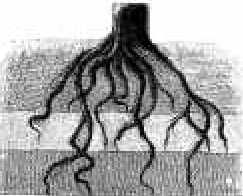Tree roots and building foundations |
|
 People often blame tree roots for causing damage of all kinds when they come into contact with urban structures like sidewalks,
asphalt driveways, outdoor staircases and sewer pipes, as well as building foundations on clay soil. Some people say that the
roots drink water from the clay, causing it to shrink and creating cracks in foundation walls that are no longer supported by
the soil.
People often blame tree roots for causing damage of all kinds when they come into contact with urban structures like sidewalks,
asphalt driveways, outdoor staircases and sewer pipes, as well as building foundations on clay soil. Some people say that the
roots drink water from the clay, causing it to shrink and creating cracks in foundation walls that are no longer supported by
the soil.
Trees have always co-existed with buildings in urban settings. And it usually doesn't take too long for their roots to fill
up any underground spaces where they find the growing conditions they need—air, water and nutrients, in order of importance. As
a rule, trees don't really cause any problems with home foundations. During prolonged summer dry spells, however, clay soil and
roots become dehydrated and that is when foundations can settle. People think that trees “send” their roots deeper into the soil
in search of water, helping to dry out the clay near the foundation walls. But the way that roots absorb water is actually more
complicated than it might seem. Because people don't fully understand the process, tree roots often get blamed when the cause
actually lies elsewhere.
To be sure, trees do draw water from the soil, but a host of other factors are also responsible for dry clay. Mineral
deposits on the surface, drainage pipes, shrubbery and garden plants, excavation trenches and poorly insulated basements, for
example, can all cause clay to become dehydrated. There is no denying, however, that the main culprit is the lack of rainfall
in summer. Each situation has to be studied and interpreted individually—it can't just be assumed that trees are to blame when
cracks appear.
It is understandable that stricter standards should be called for when homes are built on clay than on other types of soil.
For instance, foundations need to be deeper, wider and stronger to help prevent them from cracking. Perhaps these standards
were not yet in effect when your home was built, or they were ignored by the builder. You can find out more about the standards
and how to prevent cracks from forming in foundation walls by consulting the following brochures, produced by a consumer support
group in east-end Montréal for a group of homeowners experiencing problems with cracked foundations, the ACEF de l'Est de Montréal
pour le Regroupement des propriétaires de maison lézardée:
Brochures «Votre maison est fissurée» : (to be available in English soon)
· How to assess the damage and urgency of repairs
· How to prevent damage when dehydrated soil is to blame.
These printed documents (not available on the Internet) are distributed free of charge by the consumers'
group for construction quality, the Association
des Consommateurs pour la Qualité dans la Construction which can also provide you with a list of qualified professionals.
The brochures are also available from Access Montréal offices.
You may also wish to consult a consultant or tree trimmer who belongs to the provincial association of tree trimmers, the
Société Internationale d'Arboriculture du Québec.

Think carefully before planting that tree!
Do its roots extend as far as its branches?
Some forestry engineers say that root systems can extend much farther than a tree's branches. Some species can
develop roots that extend up to two or three times the tree's height!
All of this means that it's a good idea to check before planting a tree that could grow to enormous proportions
if you have a small yard. Make sure that you choose species that are adapted to your hardiness zone and growing
conditions, including the amount of light and your soil type.
Remember what they say: Great oaks from tiny acorns grow!
And be careful not to plant any species that could interfere with hydro lines. Think about how much space
you have before planting a tree that will reach a long way up and out. Check the Hydro-Québec brochure
The Right Tree, in the Right Place (not available on the Internet)..
Text adapted from a reply to a question
received by the
Montréal Botanical Garden's
Horticultural information team.
|